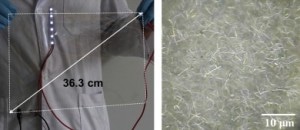Nov 23 2016
An international team of nanomaterials researchers from the University of Illinois at Chicago and Korea University have devised a low-cost and simple technique to develop a new, ultrathin film that is both highly conductive to electric current and transparent.
 Left, photograph of a large-scale silver nanowire-coated flexible film. Right, silver nanowire particles viewed under the microscope. (Credit: S.K. Yoon, Korea University)
Left, photograph of a large-scale silver nanowire-coated flexible film. Right, silver nanowire particles viewed under the microscope. (Credit: S.K. Yoon, Korea University)
The film is also stretchable and bendable, offering prospective applications in wearable electronics, flexible solar cells, roll-up touchscreen displays, and electronic skin. The results are reported in Advanced Functional Materials.
The new film is composed of fused silver nanowires, and is formed by spraying the nanowire particles via a miniature jet nozzle at supersonic speed. The result is a film with the transparency of glass and almost the electrical conductivity of silver-plate, says senior author Alexander Yarin, UIC Distinguished Professor of Mechanical Engineering.
“The silver nanowire is a particle, but very long and thin,” Yarin said. The nanowires measure approximately 20 μ long, so four laid end-to-end would cover the width of a human hair. But their diameter is a thousand times smaller — and considerably smaller than the wavelength of visible light, which reduces light scattering.
The team suspended the nanowire particles in water and propelled them by air via a de Laval nozzle, which has a similar geometry as a jet engine, but is just a few millimeters in width.
When the nanowires strike the surface they are being applied at supersonic speed, they fuse together, as their kinetic energy is turned to heat.
The liquid needs to be atomized so it evaporates in flight.
The ideal speed is 400 meters per second. If the energy is too high, say 600 meters per second, it cuts the wires. If too low, as at 200 meters per second, there’s not enough heat to fuse the wires.
Alexander Yarin, UIC Distinguished professor of mechanical engineering
The researchers applied the nanowires to flexible plastic films and to 3D objects. “The surface shape doesn’t matter,” Yarin said.
The transparent flexible film can be bent repetitively and stretched to seven times its original length and yet function, said Sam Yoon, the corresponding author of the research and a professor of mechanical engineering at Korea University.
Sometime this year, Yarin and Yoon and their colleagues created a transparent conducting film by electroplating a mat of tangled nanofiber with copper. According to Yoon, compared to that film, the new self-fused silver nanowire film provides better production rate and scalability.
It should be easier and cheaper to fabricate, as it’s a one-step versus a two-step process. You can do it roll-to-roll on an industrial line, continuously.
Alexander Yarin, UIC Distinguished professor of mechanical engineering
Co-authors with Yarin and Yoon are Jong-Gun Lee, Do-Yeon Kim, Jong-Hyuk Lee and Donghwan Kim of Korea University; Suman Sinha-Ray of the Indian Institute of Technology in Indore, India; and Mark T. Swihart of the State University of New York at Buffalo.
The research was supported by the National Research Foundation, GFHIM-2013M3A6B1078879, and the Industrial Strategic Technology Development Program, 10045221, funded by the Ministry of Knowledge Economy of Korea.